Monitoring Human Impact in Show Caves. A Study of Four Romanian Caves
Abstract
1. Introduction
2. Materials and Methods
2.1. Studied Caves
2.2. Monitoring Protocol
- -
- Installing monitoring stations in the touristic and non-touristic sectors of each cave. In these stations, the physical and hydrological parameters were recorded continuously, using dataloggers. The measurements were performed at intervals ranging between 5 and 30 min depending on the type of datalogger, the monitored parameter, and the actual situation in the field.
- -
- Periodic monitoring by spot measurements both in the fixed stations and in additional stations. Spot measurements were performed every two months using portable equipment. The measured parameters were: air temperature, relative air humidity, CO2 concentration, air speed and direction. The concentration of CO2 in the air is an important parameter both for the safety of visitors and staff, and especially because it can influence the process of precipitation or dissolution of calcium carbonate. In addition, water samples were collected for chemical analysis. Water saturation index (SI) was also calculated for it provides information on the ability of dripping water to precipitate or dissolve calcite. The SI was computed using the Langelier Saturation Index formula and the Lenntech online calculator (https://www.lenntech.com/calculators/langelier/index/langelier.htm).
- -
- -
- Radiological monitoring was performed by distributing 90 SSNTD/CR-39 radon detectors of RSKS type in 10 monitoring stations. The detectors have been installed since December 2014, and then replaced every three months, resulting in complete sets of measurements for each season. Radon measurements were reported by Burghele et al. [45,46].
- -
- The surface climate monitoring was performed by using meteorological data recorded by automatic Vaisala weather station installed at Baia de Fier (for Muierilor and Polovragi) and Chişcău village (for Urşilor and Meziad). The purpose of climate monitoring was to anticipate the response time and amplitude of microclimate changes and hydrological parameters in the cave to meteorological phenomena (mainly temperature and precipitation).
2.3. Vulnerability Maps
3. Results
3.1. Muierilor Cave
3.1.1. Temperature
3.1.2. Tourist Traffic
3.1.3. Air Relative Humidity (RH)
3.1.4. Air CO2 Concentration
3.1.5. Air Speed
3.1.6. Drip Rate
3.1.7. Physicochemical Parameters of Drip Water
3.2. Polovragi Cave
3.2.1. Temperature
3.2.2. Tourist Traffic
3.2.3. Influence of Lighting Sources
3.2.4. Relative Humidity
3.2.5. Air CO2 Concentration
3.2.6. Air Speed
3.2.7. Drip Rate
3.2.8. Physicochemical Parameters of Drip Water
3.3. Urșilor Cave
3.3.1. Air Temperature
3.3.2. The Influence of Tourist Traffic
3.3.3. Influence of the Lighting Sources
3.3.4. Relative Humidity
3.3.5. CO2 Concentration in the Air
3.3.6. Air Speed
3.3.7. Drip Rate
3.3.8. Physicochemical Parameters of Drip Water
3.4. Meziad Cave
3.4.1. Air Temperature
3.4.2. Tourist Traffic
3.4.3. Influence of Lighting Sources
3.4.4. Relative Humidity
3.4.5. CO2 Concentration in the Air
3.4.6. Air Speed
3.4.7. Drip Rate
3.4.8. Physicochemical Parameters of Drip Water
4. Discussion
4.1. Muierilor Cave
4.2. Polovragi Cave
4.3. Urșilor Cave
4.4. Meziad Cave
5. Conclusions Concerning the Protection and Management Measures
- (i)
- Firstly, the lighting system caused problems by the development of lampenflora. Changing to LED lighting has no effect if the existing lampenflora is not totally removed. Controlling the lighting remains a long-term mitigation measure that must be undertaken permanently through a combination of lampenflora early removal and adjusting of illuminance levels (both light intensity and lighting time).
- (ii)
- In caves with no natural entrance(s), such as Urșilor, a continuous monitoring of CO2 levels should be complemented by occasional ventilation through the airlocks during the high season. However, such measures should be taken on a case-by-case basis and only until low-CO2 levels (those of low-season) are restored.
- (iii)
- In caves such as Meziad, where vulnerability shows a seasonal variability, seasonal changes of the touristic circuits may be applied with benefits to both cave environment and visitors’ health. Finally, microbiological monitoring of surfaces should be routinely done to counter both pathogens introduced by visitors and cave fauna such as bats.
Supplementary Materials
Author Contributions
Funding
Institutional Review Board Statement
Informed Consent Statement
Data Availability Statement
Acknowledgments
Conflicts of Interest
References
- Dredge, J.; Fairchild, I.J.; Harrison, R.M.; Fernandez-Cortés, A.; Sanchez-Moral, S.; Jurado, V.; Gunn, J. Cave aerosols: Distribution and contribution to speleothem geochemistry. Quat. Sci. Rev. 2013, 63, 23–41. [Google Scholar] [CrossRef]
- Fairchild, I.J.; Smith, C.L.; Baker, A.; Fuller, L.; Spötl, C.; Mattey, D.; McDermott, F.; E.I.M.F. Modification and preservation of environmental signals in speleothems. Earth-Sci. Rev. 2006, 75, 105–153. [Google Scholar] [CrossRef]
- UNESCO World Heritage List. Available online: https://whc.unesco.org/en/list/ (accessed on 30 December 2020).
- Saiz-Jimenez, C.; Cuezva, S.; Jurado, V.; Fernandez-Cortes, A.; Porca, E.; Benavente, D.; Cañevaras, J.C.; Sanchez-Moral, S. Paleolithic Art in Peril: Policy and Science Collide at Altamira Cave. Science 2011, 334, 42–43. [Google Scholar] [CrossRef]
- Clottes, J.; Gély, B.; Ghemis, C.; Kaltnecker, E.; Lascu, V.-T.; Moreau, C.; Philippe, M.; Prud’homme, F.; Valladas, H. Un art très ancien en Roumanie. Les dates de Coliboaia. Int. Newsl. Rock Art 2011, 61, 1–3. [Google Scholar]
- Bourges, F.; Genthon, P.; Mangini, A.; D’Hulst, D. Microclimates of L’Aven d’Orgnac and other French limestone caves (Chauvet, Esparros, Marsoulas). Int. J. Climatol. 2006, 26, 1651–1670. [Google Scholar] [CrossRef]
- Fernandez-Cortes, A.; Calaforra, J.M.; Jiménez-Espinosa, R.; Sánchez-Martosa, F. Geostatistical spatiotemporal analysis of air temperature as an aid to delineating thermal stability zones in a potential show cave: Implications for environmental management. J. Environ. Manag. 2006, 81, 371–383. [Google Scholar] [CrossRef]
- Fong, D.W. Management of subterranean fauna in karst. In Karst Management; Van Beynen, P.E., Ed.; Springer: Dordrecht, The Netherlands, 2011; pp. 201–224. [Google Scholar]
- Lee, N.M.; Meisinger, D.B.; Aubrecht, R.; Kovacik, L.; Saiz-Jimenez, C.; Baskar, S.; Baskar, R.; Liebl, W.; Porter, M.L.; Engel, A.S. Caves and karst environments. In Life at Extremes: Environments, Organisms and Strategies for Survival; Bell, E.M., Ed.; CAB International: Wallingford, UK, 2012; pp. 320–344. [Google Scholar]
- Cigna, A.A. The problem of lampenflora in show caves. Acta Carsologica Slovaca 2012, 50, 5–10. [Google Scholar]
- Mulec, J. Human impact on underground cultural and natural heritage sites, biological parameters of monitoring and remediation actions for insensitive surfaces; case of Slovenian show caves. J. Nat. Conserv. 2014, 22, 132–141. [Google Scholar] [CrossRef]
- Heaton, T.H.E. Isotopic studies of nitrogen pollution in the hydrosphere and atmosphere: A review. Chem. Geol. Isot. Geosci. Sect. 1986, 59, 87–102. [Google Scholar] [CrossRef]
- Moldovan, O.; Racoviţă, G.; Rajka, G. The impact of tourism in Romanian show caves: The example of the beetle populations in the Urşilor Cave of Chişcău (Transylvania, Romania). Subterr. Biol. 2003, 1, 73–78. [Google Scholar]
- Bercea, S.; Năstase-Bucur, R.; Moldovan, O.T.; Kenesz, M.; Constantin, S. Yearly microbial cycle of human exposed surfaces in show caves. Subterr. Biol. 2019, 31, 1–14. [Google Scholar] [CrossRef]
- Cigna, A.A.; Burri, E. Development, management and economy of show caves. Int. J. Speleol. 2000, 29B, 1–27. [Google Scholar] [CrossRef]
- Cigna, A.A. Environmental management of tourist caves. Environ. Geol. 1993, 21, 173–180. [Google Scholar] [CrossRef]
- Bunting, B.; Megan, R.; Balks, M.R. A quantitative method for assessing the impacts of recreational cave use on the physical environment of wild caves. Ackma J. 2001, 44, 10–18. [Google Scholar]
- Calaforra, J.M.; Fernandez-Cortez, A.; Sanchez-Martos, F.; Gisbert, J.; Pulido-Bosch, A. Environmental Control for Determining Human Impact and Permanent Visitor Capacity in a Potential Show Cave Before Tourist Use. Environ. Conserv. J. 2003, 30, 150–167. [Google Scholar] [CrossRef]
- Fernandez-Cortes, A.; Calaforra, J.M.; Sanchez-Martos, F. Spatiotemporal Analysis of Air Condition as a Tool for the Environmental Management of a Show Cave (Cueva del Agoa, Spain). Atmo. Environ. 2006, 40, 7378–7394. [Google Scholar] [CrossRef]
- Russell, M.J. and McLean, V.L. Management Issues in a Tasmanian Tourist Cave: Potential Microclimate Impacts of Cave Modifications. J. Environ. Manag. 2008, 87, 474–483. [Google Scholar] [CrossRef]
- De Freitas, C.R. The role and importance of cave microclimate in the sustainable use and management of show caves. Acta Carsol. 2010, 39, 477–489. [Google Scholar] [CrossRef]
- Lario, J.; Soler, V. Microclimate Monitoring of Pozalagoa Cave (Vizcaya, Spain): Application to Management and Protection Show Cave Climate Monitoring of Pozalagoa Cave. J. Cave Karst Stud. 2010, 72, 169–180. [Google Scholar] [CrossRef]
- Šebela, S.; Prelovšek, M.; Janez, T. Impact of Peak Period Visits on the Postojna Cave (Slovenia) Microclimate. Appl. Clim. 2013, 111, 51–64. [Google Scholar] [CrossRef]
- Šebela, S.; Turk, J. Natural and Anthropogenic Influences on the Year-Round Temperature Dynamics of Air and Water in Postjona Show Cave. Tour. Manag. 2014, 40, 233–243. [Google Scholar] [CrossRef]
- Moldovan, O.T.; Constantin, S.; Cheval, S. Drip heterogeneity and the impact of decreased flow rates on the vadose zone fauna in Ciur-Izbuc Cave, NW Romania. Ecohydrology 2018, 11, e2028. [Google Scholar] [CrossRef]
- Bourges, F.; Genty, D.; Genthon, P.; Mangini, A.; D’Hulst, D. South-France caves monitoring: Present day cave air dynamics characterization, paleoclimatic and archaeological interests. Geophys. Res. Abstr. 2012, 14, EGU2012-5830. [Google Scholar]
- Sanchez-Moral, S.; Portillo, M.C.; Jancies, I.; Cuezva, S.; Fernandez-Cortes, A.; Canaveras, J.C.; Gonzales, J.M. The role of microorganisms in the formation of calcitic moonmilk deposits and speleothems in Altamira Cave. Geomorphology 2012, 139–140, 285–292. [Google Scholar] [CrossRef][Green Version]
- WHO (World Health Organization). WHO Handbook on Indoor Radon. A Public Health Perspective. 2009. Available online: http://www.who.int/ionizing_radiation/env/radon/en/index1.html (accessed on 20 December 2020).
- UNSCEAR (United Nations Scientific Committee on the Effects of Atomic Radiation); Annex, E. Sources-to-effects Assessment for Radon in Homes and Workplaces. UNSCEAR 2006 Rep. 2009, 2, 197–334. [Google Scholar]
- ICRP (International Commission on Radiological Protection). Lung Cancer Risk from Radon and Progeny and Statement on Radon. Ann. ICRP 2010, 40, 1–64. [Google Scholar] [CrossRef]
- Lario, J.; Sanchez-Moral, S.; Canaveras, J.C.; Cuezva, S.; Soler, V. Radon continuous monitoring in Altamira Cave (northern Spain) to to assess user’s annual effective dose. J. Environ. Radioact. 2005, 80, 161–174. [Google Scholar] [CrossRef]
- Vaupotic, J. Nanosize radon short-lived decay products in the air of the Postojna Cave. Sci. Total Environ. 2008, 393, 27–38. [Google Scholar] [CrossRef]
- Kávási, N.; Somlai, J.; Szeiler, G.; Szabó, B.; Schafer, I.; Kovács, T. Estimation of effective doses to cavers based on radon measurements carried out in seven caves of the Bakony Mountains in Hungary. Radiat. Meas. 2010, 45, 1068–1071. [Google Scholar] [CrossRef]
- Tsvetkova, T.; Przylibski, T.A.; Nevinskaya, I.; Nevinskaya, V. Measurement of radon in the East Europe under the ground. Radiat. Meas. 2005, 40, 98–105. [Google Scholar] [CrossRef]
- Sainz, C.; Quindós, L.S.; Fuent, I.; Nicolás, J.; Luis, Q. Analysis of the main factors affecting the evaluation of the radon dose in workplaces: The case of tourist caves. J. Hazar. Math. 2007, 145, 368–371. [Google Scholar] [CrossRef] [PubMed]
- Racovita, G.; Boghean, V.; Petrescu, M. Le bilan topoclimatique de la grotte du Closani (Monts Mehedinti, Roumanie). Appl. Karstol. 1993, 6, 7–86. [Google Scholar]
- Racovita, G.; Moldovan, O.; Rajka, G. Données préliminaires sur l’environement de la Grotte des Ours en régime d’exploitation touristique. Apppl. Karstol. 1999, 11–12, 61–74. [Google Scholar]
- Borda, C.; Borda, D. Airborne microorganisms in show caves from Romania. Trav. Inst. Spéol. Emile Racovitza 2005, 43–44, 65–73. [Google Scholar]
- Fejer, A.; Moldovan, O.T. Population size and dispersal patterns for a Drimeotus (Coleoptera, Leiodidae, Leptodirini) cave population. Subt. Biol. 2013, 11, 31–44. [Google Scholar]
- Soficaru, A.; Dobos, A.; Trinkaus, E. Early modern humans from the Peştera Muierii, Baia de Fier, Romania. Proc. Nati. Acad. Sci. USA 2006, 103, 17196–17201. [Google Scholar] [CrossRef]
- Mirea, I.-C.; Robu, M.; Petculescu, A.; Kenesz, M.; Faur, L.; Arghir, R.; Tecsa, V.; Timar-Gabor, A.; Roban, R.-D.; Panaiotu, C.-G.; et al. Last deglaciation flooding events in the South Carpathians as revealed by the study of cave deposits from Muierilor Cave, Romania. Palaeogeogr. Palaeoclim. Palaeoecol. 2020, 562, 110084. [Google Scholar] [CrossRef]
- Moldovan, O.T.; Iepure, S.; Brad, T.; Kenesz, M.; Mirea, I.C.; Năstase-Bucur, R. Database of Romanian cave invertebrates with a Red List of cave species and a list of hotspot/coldspot caves. Biodiv. Data J. 2020, 8, e53571. [Google Scholar] [CrossRef]
- Bercea, S.; Nastase-Bucur, R.; Mirea, I.C.; Mantoiu, D.S.; Kenesz, M.; Petculescu, A.; Baricz, A.; Andrei, A.-S.; Banciu, H.L.; Papp, B.; et al. Novel approach to microbiological air monitoring in show caves. Aerobiology 2018, 34, 445–468. [Google Scholar] [CrossRef]
- Moldovan, O.-T.; Bercea, S.; Nastase-Bucur, R.; Constantin, S.; Kenesz, M.; Mirea, I.C.; Petculescu, A.; Robu, M.; Arghir, R.A. Management of water bodies in show caves—A microbial approach. Tour. Manag. 2020, 78, 104037. [Google Scholar] [CrossRef]
- Burghele, B.D.; Cucoș, A.; Papp, B.; Dicu, T.; Pressyanov, D.; Dimitrov, D.; Dimitrova, I.; Constantin, S. Comparative study of radon and thoron measurements in four Romanian show caves. Radiat. Prot. Dosim. 2017, 177, 181–185. [Google Scholar] [CrossRef] [PubMed]
- Burghele, B.D.; Cucos, A.; Papp, B.; Stetca, F.A.; Mirea, I.; Constantin, S. Distribution of Radon gas in Romanian show caves and radiation safety. Radiat. Prot. Dosim. 2018, 181, 1–5. [Google Scholar] [CrossRef] [PubMed]
- Ponta, G.; Aldica, G. Peşteri din Cheile Olteţului—Polovragi. Bul. Speologic 1985, 10, 245–268. [Google Scholar]
- Constantin, S.; Robu, M.; Munteanu, C.M.; Petculescu, A.; Vlaicu, M.; Mirea, I.; Kenesz, M.; Drăguşin, V.; Hoffmann, D.; Anechitei, V.; et al. Reconstructing the evolution of cave systems as a key to understanding the taphonomy of fossil accumulations: The case of Urşilor Cave (Western Carpathians, Romania). Quat. Int. 2014, 339–340, 25–40. [Google Scholar] [CrossRef]
- Rusu, T.; Racoviță, T.; Crăciun, V. La grotte du Meziad. Aspects physico-géographiques, genèse et evolution de la cavité. Trav. Instit. Spéol. E Racovitza 1974, 13, 147–173. [Google Scholar]
- Sibson, R. A brief description of natural neighbor interpolation, interpolating multivariate data. In Multivariate Data; Barnett, V., Ed.; Wiley: New York, NY, USA, 1981; pp. 21–36. [Google Scholar]
- Azuma, K.; Kagi, N.; Yanagi, U.; Osawa, H. Effects of low-level inhalation exposure to carbon dioxide in indoor environments: A short review on human health and psychomotor performance. Environ. Int. 2018, 121, 51–56. [Google Scholar] [CrossRef]
- *** Norme generale de protectia muncii. (in Romanian in original; General norms for work protection). OMMSS 508/2002. 2002.
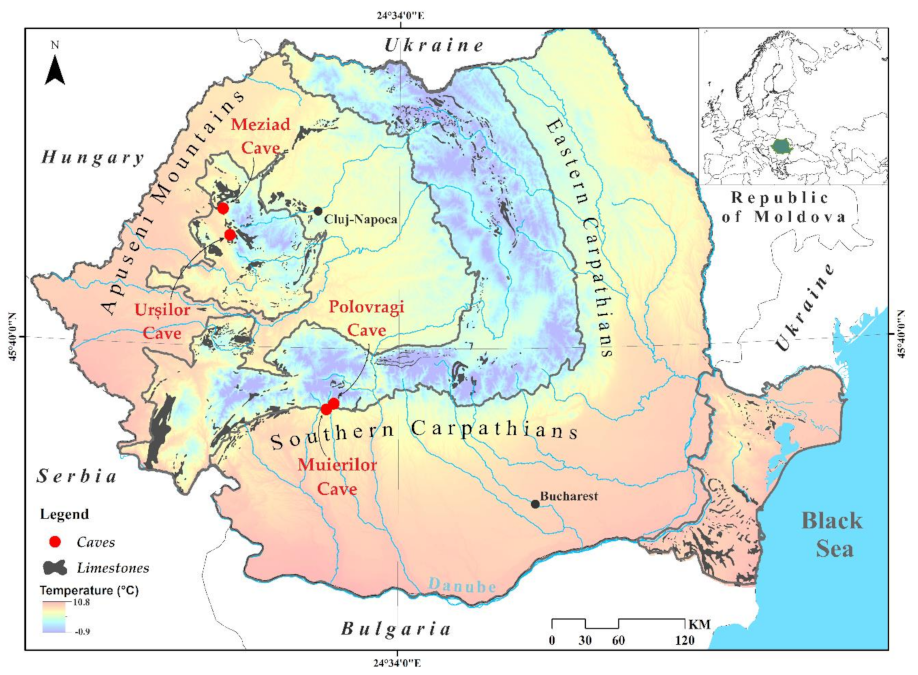
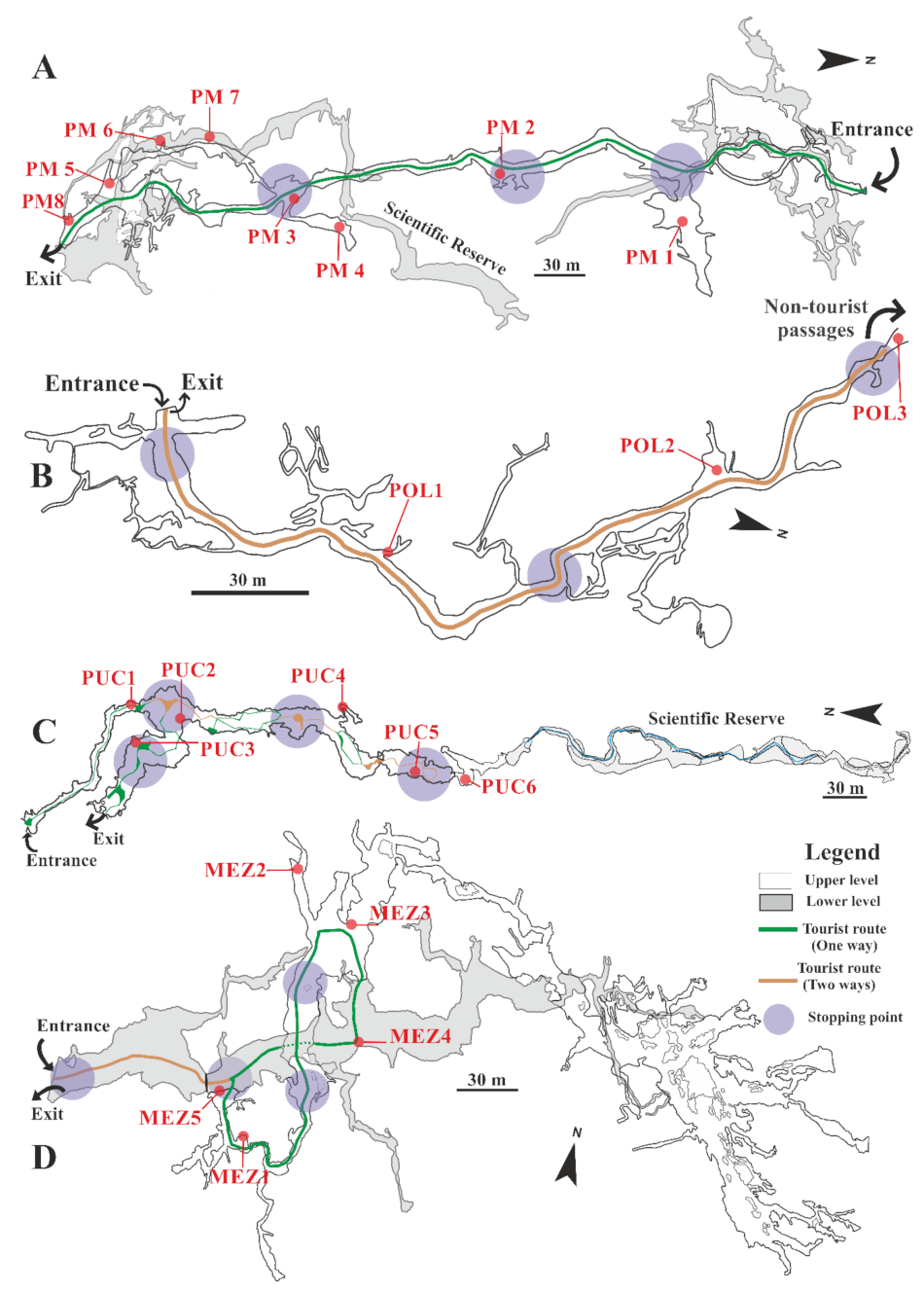
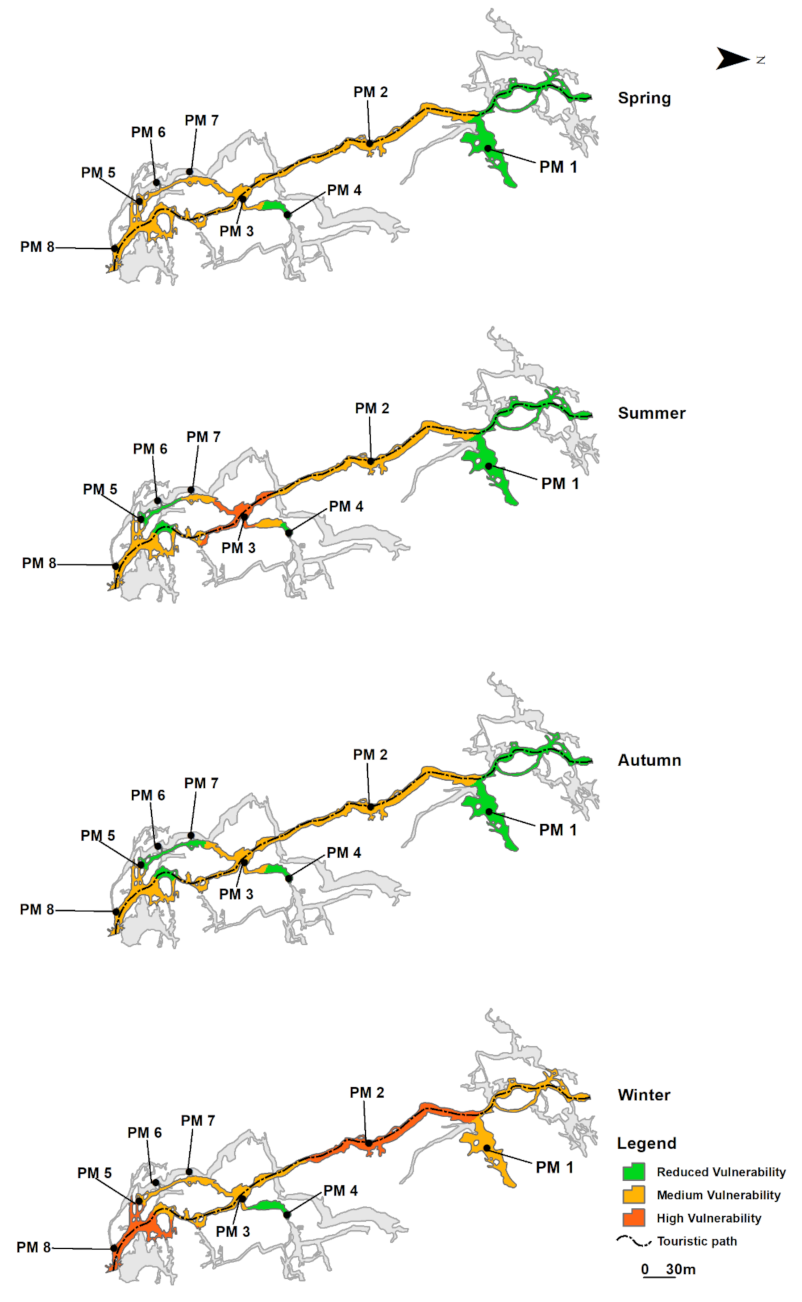
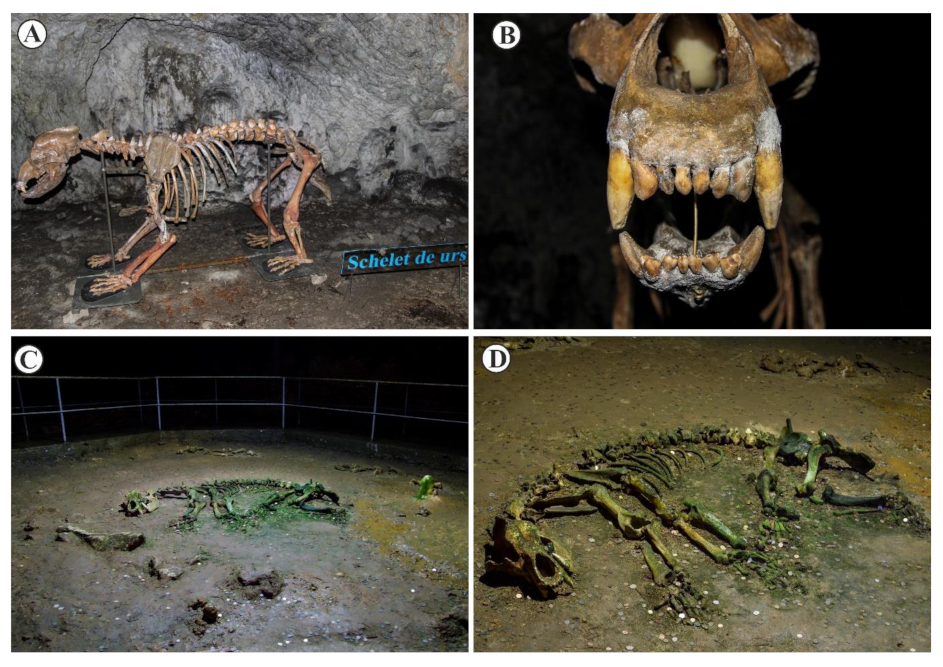
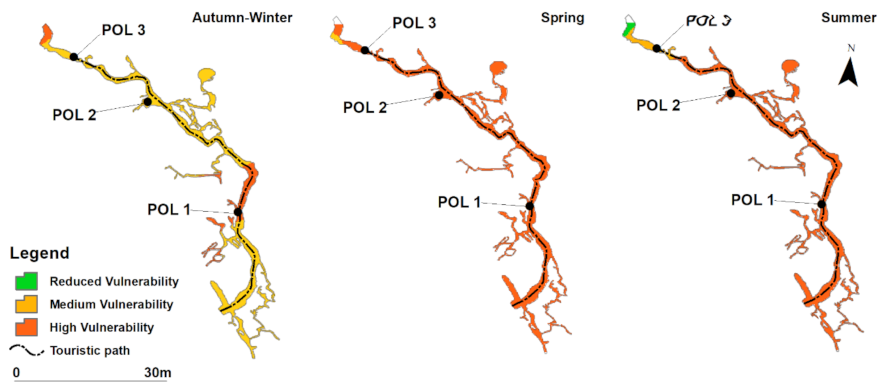
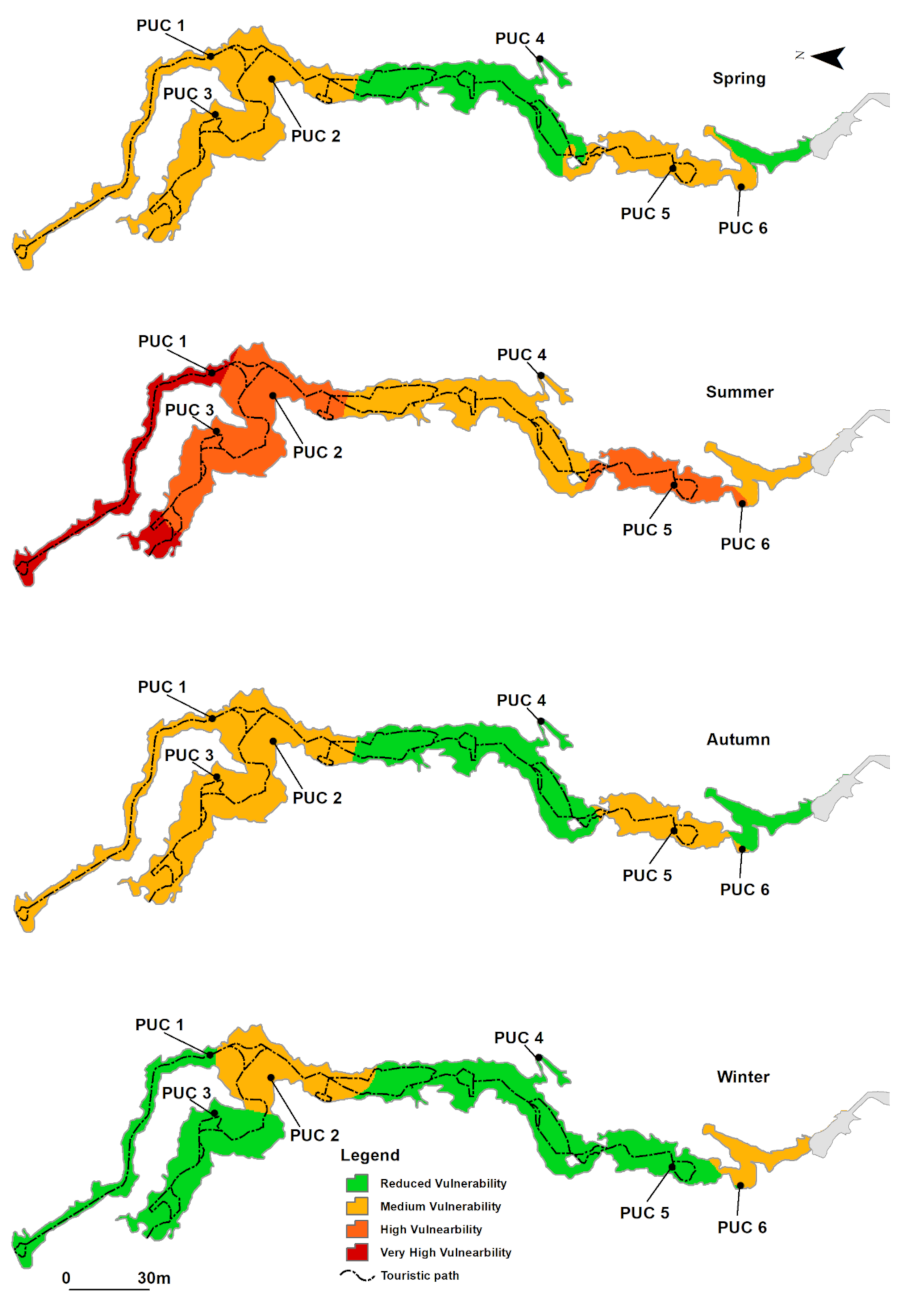
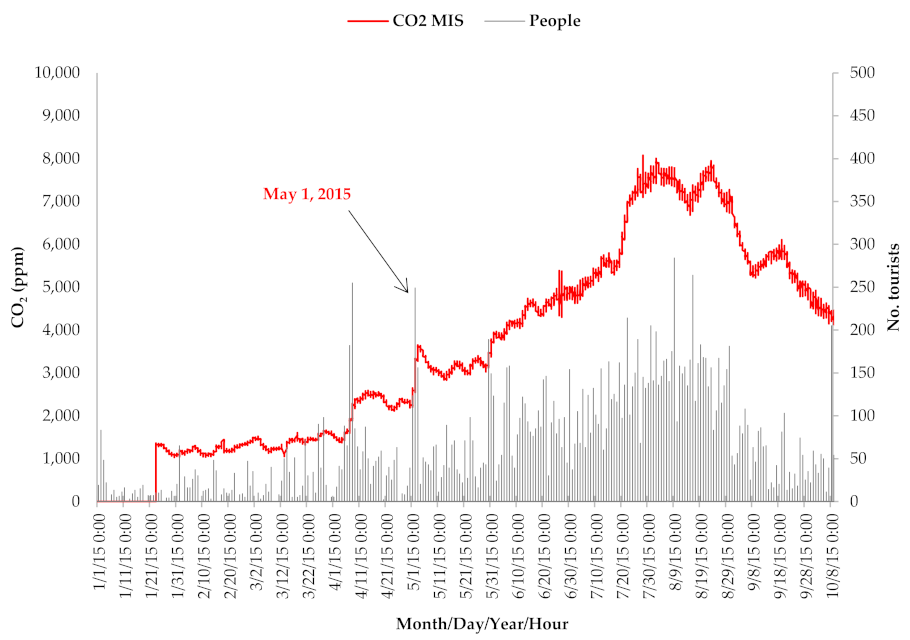
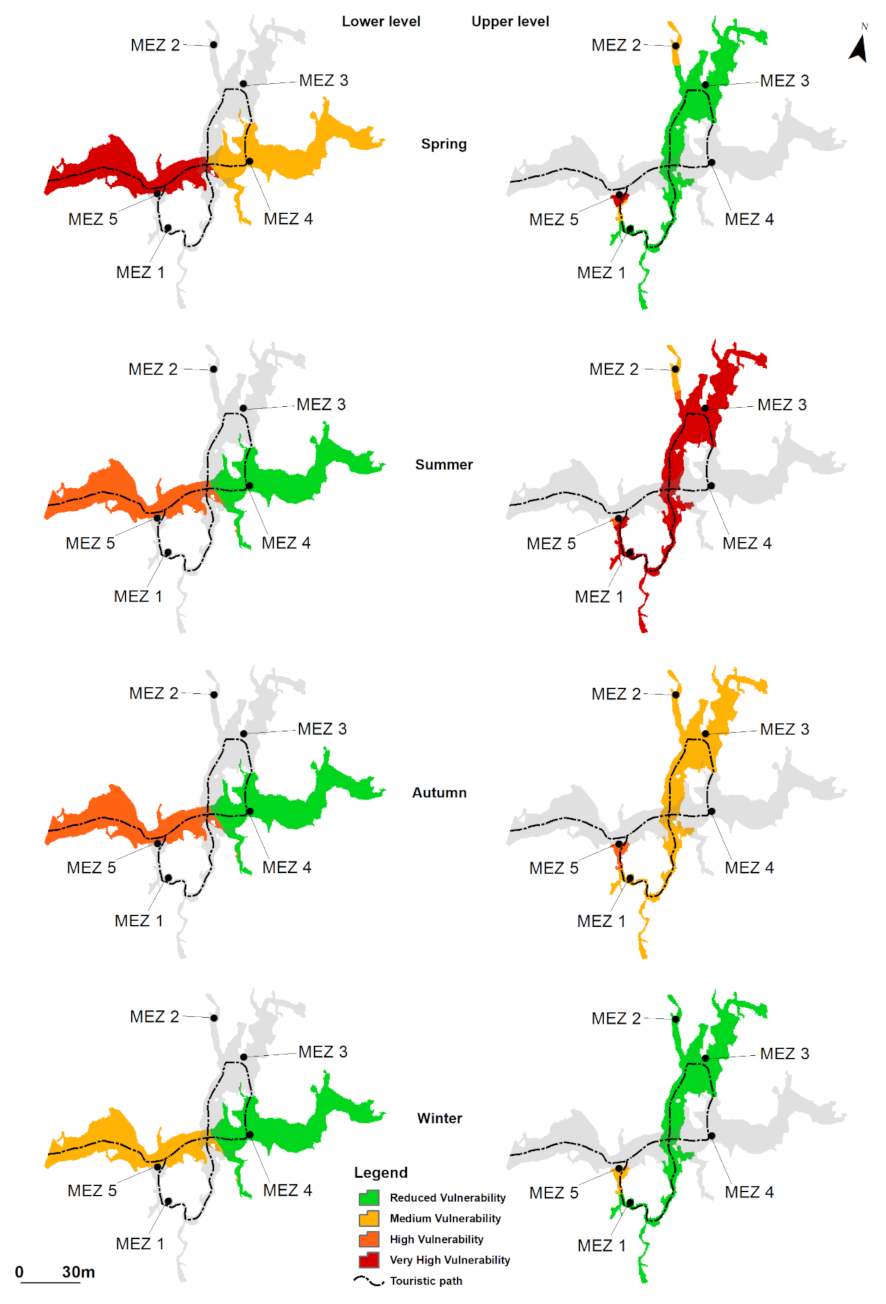
| Threat | Cause | Effects |
|---|---|---|
| Changes of natural air circulation | Opening of artificial entrances, changes in cave passage geometry |
|
| Changes of cave temperature | Local warming due to electric lights Periodic temperature fluctuations from visitors’ flux |
|
| Changes of cave air CO2 concentrations | CO2 from visitors CO2 from other sources |
|
| Organic matter input | Organic matter carried by visitors (dust, lints, spores, microbes, etc.) |
|
| Chemical pollutants | Detergents input during maintenance work (e.g., washing paths, maintenance, etc.) |
|
| Noise | ultrasonic noise from electrical equipment (e.g., transformers) or visitors’ noise |
|
| Cave | No. Entrances | Type | Elevation (m a.s.l.) | Rock Thickness Above (m) | Lighting System | Tourist Path Length (m) | Visit Time (Mean Min.) |
|---|---|---|---|---|---|---|---|
| Muierilor | 3 | 2 naturals 1 artificial | 650 | 100 | Switched off after each visited sector | 800 | 30–55 |
| Polovragi | 6 | 1 artificial 5 naturals | 645 | 250 | Switched off after each visit | 500 | 25–50 |
| Urșilor | 2 | 2 artificials | 490 | 100 | Switched off after each visited sector | 450 | 30–45 |
| Meziad | 3 | 3 naturals | 435 | 80 | Switched off after each visited sector | 1000 | 30–60 |
| No. | Cave/Protocol | Muierilor | Polovragi | Urșilor | Meziad | |
|---|---|---|---|---|---|---|
| 1 | Number of stations: touristic/non-touristic passages | 5/3 | 2/1 | 3/2 | 4/1 | |
| 2 | Tourist traffic continuous | Long Range Infrared (LIR) people counter (Chambers Electronics) | ||||
| 3 | Temperature (°C) | T continuous | Hobo Pendant UA-002-64 Tinytag | Hobo Pendant UA-002-64 | Microstep MIS (Slovakia) | Hobo Pendant UA-002-64 |
| T spot | Every 2nd month | |||||
| 4 | Combined temperature + Light | Hobo Pendant UA-002-64 | ||||
| 5 | Relative air humidity (RH; %) | RH continuous | Tinytag | Microstep MIS (Slovakia) | ||
| RH spot | Vaisala GMP222 | |||||
| 6 | Air CO2 (ppm) | CO2 continuous | iSense (CO2 m) | iSense (CO2m) | Vaisala GMP222 | iSense (CO2m) |
| CO2 spot | Vaisala GM70 + GMP222 probe every 2nd month | |||||
| 7 | Air speed and direction (m/s); spot | PCE-423 Hot Wire Anemometer every 2nd month | ||||
| 8 | Drip rate (L/h) | Stalagmate Mark3 | ||||
| 5 stations | 2 stations | 4 stations | 2 stations | |||
| 9 | Conductivity (µS/cm), pH | WTW ph/conductivity meter every 2nd month; 2 stations | ||||
| 10 * | Microbiological monitoring: Enterobacteriaceae | Every 2nd month | ||||
| 11 * | Radon | Continuous | ||||
| PARAMETER × WEIGHT (Abbreviation) | CATEGORY | |||
|---|---|---|---|---|
| 0 | 10 | 20 | ||
| 1 | Temperature (°C) × 2 (T) | Seasonal variation <1 | Seasonal variation 1–2 | Seasonal variations> 2C |
| 2 | RH (%) × 2 (RH) | Variation <5 | Variation 5–10 | Variation >10% |
| 3 | CO2 (ppm) × 2 (CO2) | <5000 | 5000–10,000 | >10,000 |
| 4 | Saturation index × 1 (SI) | (−0.5)–0.5 | ±0.1 | >±0.1 |
| 5 | Drip rate (L/h) × 1 (DR) | Constant flow <25 | Short interruptions 25–50 | Long interruptions >50% |
| 6 | Bats number × 1 (Bats) | None | Few dozens | Big colonies |
| 7 | Microorganisms (CFU */m3) × 1 (Microorg.) | <50 | 50–500 | >500 |
| 8 | Tourist number/season × 2 (Tourists) | <2500 | 2500–5000 | >5000 |
| Stations/Parameters | PM1 | PM2 | PM3 | PM4 | PM5 | PM6 | PM7 | PM8 |
|---|---|---|---|---|---|---|---|---|
| T °C min-max mean | 7.5–10.5 9.1 | 6.9–10.7 8.5 | 8.3–10.5 9.2 | 9.6–11.8 10.9 | 5.9–11.6 11.2 | 7.1–11.6 9.7 | 0.8–14.7 8.4 | |
| Tourist traffic (no./h) | <250 | |||||||
| RH (%) | >90 | >90 | >90 | >90 | >90 | >95 | >40 | |
| CO2 (ppm) | 400–1000 | 400–1000 | 400–1000 | 400–1000 | 400–1000 | |||
| Air speed (m/s; mean) | 0.2 | 0 | 0 | 0 | 0 | 0 | 0 | |
| Drip rate (L/h; min-max) | 0–1.15 | 0–1.38 | 0–0.28 | 0–20.46 | 0–14.79 | |||
| Conductivity (µS/cm) | 336–368 | 355–382 | 432–453 | 360–406 | 305–396 | |||
| pH (min-max) | 7.4–8.3 | 7.3–8.2 | 7.3–8.2 | 7.3–8.3 | 7.1–8.2 | |||
| SI (min-max) | (−0.46)–0.58 | (−0.31)–0.53 | (−0.24)–0.54 | (−0.32)–0.51 | (−0.31)–0.51 |
| Stations/Parameters | Pol1 | Pol2 | Pol3 |
|---|---|---|---|
| T air °C min-max | 7.7–9.1 | 8.3–9.6 | 8–8.5 |
| mean | 8.4 | 8.4 | 8.2 |
| Tourist traffic (no/h) | <120 | ||
| RH (%) | >90 | >95 | >99 |
| CO2 (ppm) | <1260 | <1040 | <1000 |
| Air speed (m/s) | 0.02–0.11 | 0 | 0 |
| Drip rate (L/h; min-max) | 0–0.8 | 0–3.5 | |
| Conductivity (µS/cm) min-max | 223–270 | 342–396 | |
| pH (min-max) | 6.8–8.2 | 7.2–8.1 | |
| SI (min-max) | (−0.74)–(−0.023) | (−0.04)–0.4 |
| Stations/ Parameters | PUC1 | PUC2 | PUC3 | PUC4 | PUC5 | PUC6 |
|---|---|---|---|---|---|---|
| T air °C min-max mean | 10.2–11.1 10.4 | 10.3–11.1 10.4 | 10.5 (+0.1 in summer) | 10.1–11.1 10.3 | 9.6 (constant) | |
| Tourist traffic (no./h) | <500 | |||||
| RH (%) | >98 | >98 | >98 | >98 | >98 | |
| CO2 (ppm) | >10000 | <8000 | <8140 | <6500 | <7800 | |
| Air speed (m/s) | <0.46 | <0.42 | <0.57 | |||
| Drip rate (L/h; min-max) | 0.03–1.34 | 0.014–0.22 | 0–0.03 | 0.14–2.5 | 0.03–0.65 | |
| Conductivity (µS/cm) | 419–441 | 304–445 | 228–384 | 407–431 | 331–392 | |
| pH (min–max) | 7.3–8.0 | 7.4–8.1 | 7.6–8 | 7.3–8.2 | 7.3–8.3 | |
| SI (min–max) | (−0.069)–0.42 | (−0.07)−0.2 | (−0.29)–0.04 | (−0.15)–0.1 | (−0.32)–(−0.05) |
| Stations/ Parameters | Mez1 | Mez2 | Mez3 | Mez4 | Mez5 |
|---|---|---|---|---|---|
| T °C min-max mean | 11.5–22.3 14.2 | 11.3–13.6 12.2 | 11.7–17.3 13.4 | 0.0–14.2 9.1 | −3.8–15.3 9.7 |
| Tourist traffic (no./h) | <136 | ||||
| RH (%) | 60–100 | >90 | 80–100 | 80–100 | 80–100 |
| CO2 (ppm) | 400–850 | <1800 (June–September) | <1100 | ||
| Air speed (m/s; min-max) | 0.02–0.2 | 0 | 0–0.04 | 0.01–0.2 | 0–0.24 |
| Drip rate (L/h) | 0.45 | 0.1 | |||
| Conductivity (µS/cm) | 527–593 | 400–440 | |||
| pH (min-max) | 7.6–8.1 | 7.5–8.2 | |||
| SI (min-max) | 0.19–0.6 | 0.01–0.42 |
Publisher’s Note: MDPI stays neutral with regard to jurisdictional claims in published maps and institutional affiliations. |
© 2021 by the authors. Licensee MDPI, Basel, Switzerland. This article is an open access article distributed under the terms and conditions of the Creative Commons Attribution (CC BY) license (http://creativecommons.org/licenses/by/4.0/).
Share and Cite
Constantin, S.; Mirea, I.C.; Petculescu, A.; Arghir, R.A.; Măntoiu, D.Ș.; Kenesz, M.; Robu, M.; Moldovan, O.T. Monitoring Human Impact in Show Caves. A Study of Four Romanian Caves. Sustainability 2021, 13, 1619. https://doi.org/10.3390/su13041619
Constantin S, Mirea IC, Petculescu A, Arghir RA, Măntoiu DȘ, Kenesz M, Robu M, Moldovan OT. Monitoring Human Impact in Show Caves. A Study of Four Romanian Caves. Sustainability. 2021; 13(4):1619. https://doi.org/10.3390/su13041619
Chicago/Turabian StyleConstantin, Silviu, Ionuț Cornel Mirea, Alexandru Petculescu, Răzvan Adrian Arghir, Dragoș Ștefan Măntoiu, Marius Kenesz, Marius Robu, and Oana Teodora Moldovan. 2021. "Monitoring Human Impact in Show Caves. A Study of Four Romanian Caves" Sustainability 13, no. 4: 1619. https://doi.org/10.3390/su13041619
APA StyleConstantin, S., Mirea, I. C., Petculescu, A., Arghir, R. A., Măntoiu, D. Ș., Kenesz, M., Robu, M., & Moldovan, O. T. (2021). Monitoring Human Impact in Show Caves. A Study of Four Romanian Caves. Sustainability, 13(4), 1619. https://doi.org/10.3390/su13041619








